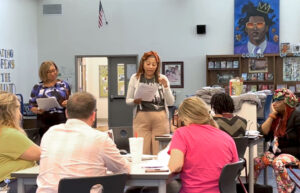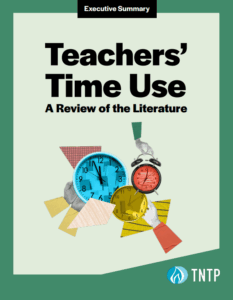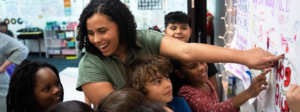For more than two decades, TNTP has operated a summer pre-service training (PST) as part of our Teaching Fellows programs. But this past summer, the COVID-19 pandemic forced us to provide training virtually for the first time. While it was challenging preparing for such a huge shift on a short timeline, we’re excited about some of the successes we’ve already seen:
- Even amid the uncertainty, we saw a 22% increase from last year in the number of participants who started training. Overall, we ended the summer with more than 300 Fellows–67% of whom identify as Black, Indigenous, or people of color–ready to start teaching.
- Across the board, we heard great things about the ways our sites built a sense of community for their participants, with 92% of participants who completed a survey at the end of training reporting they felt “a strong sense of connection and community with other teachers in the program.”
- Most importantly, our participants felt prepared to deliver content and instruction this year. On average, we saw an 11 percentage point increase in participants who reported that “pre-service training is preparing me with the appropriate skills to master the most meaningful content for my subject area and grade level” compared to 2019.
We recently interviewed Sarah Arntsen, a Partner at TNTP who helped lead this work, to learn more about this year’s virtual training experience. That conversation is below.
And if you or someone you know is interested in becoming a teacher next fall, the application for TNTP Teaching Fellows is now open.
Why did you decide to hold a virtual PST this summer?
It wasn’t even much of a question for us—we knew that we had to pivot our approach to support students and school system partners. Pandemic or not, students need great teachers. And we were in a position to help meet that need. It was a question of how to best do it, not whether to do it at all.
We first gathered the teams from our sites and put together a task force. We outlined the different elements of the work that we needed to accomplish—both what we needed to do to train new Fellows, and how we could continue to support our current Fellows throughout the year.
As you can imagine, there were lots of problems we needed to solve to make this work. For instance, at each of our sites, we hire seasonal staff to support PST. How could we train them virtually? During PST, how could we give participants meaningful practice opportunities to develop their teaching skills? And if they weren’t going to engage in field experience with students, how would our evaluation model need to shift?
Ultimately, I’m proud to say that we put together engaging programs that participants felt good about. Despite the uncertainty, all of our sites exceeded enrollment targets, and we ended the summer with over 300 Fellows ready to start teaching.
Obviously, not every skill teachers need can be taught virtually. Which skills translated well?
First, it’s important to note that since TNTP is itself a virtual organization, we already had a ton of experience with online learning, which made it easier. We were already comfortable with the technology, and also were familiar with many distance learning best practices.
In terms of specific skills, we were able to spend more time on instructional planning—how do you create and deliver a solid lesson? How do you ensure the assignments you’re putting in front of students are grade appropriate and aligned to standards? Using virtual tools like breakout rooms and videos, our Fellows had lots of opportunities to observe great teaching in action, practice, and give and receive feedback. Content-specific training—meaning skills for teaching a particular subject like math or literacy—also was relatively easy to do virtually.
On a different note, one of the key principles of PST is the importance of a strong culture in each Fellows cohort. Especially once the school year starts, it is invaluable for them to have those connections with peers so they can problem-solve, as well as just unwind and relax. Thanks to the creativity of our instructors and Fellows, we were able to do that virtually, with cooking classes, happy hours, virtual dance parties, and other fun activities.
Which skills didn’t translate as well?
Ultimately, you can’t completely replicate what it’s like to be the sole leader in front of a group of students. Building a classroom community and culture is so important, and the only real way to learn how to do it is to actually do it. So we know that our Fellows will need intensive coaching support in that area this year.
That said, we’ve gotten creative to help Fellows practice some of those skills. In the Baltimore City Teaching Residency PST, for instance, Fellows taught simulated classes with their peers acting as students—and some “students” were told in advance to say certain things or provide an incorrect answer that the Fellow would then need to address. We also had specific training to help them build relationships with individual students.
Are there any lessons or innovations that you think we will carry over to future PSTs that are in-person?
Virtual programming is by its nature more flexible. There were certain modules that we were able to record for Fellows to watch at their convenience, which is a good thing. One concern we’ve heard from Fellows in past years is that in-person training over the summer can be a financial burden since they don’t receive their first paycheck from school until the fall. This is especially a barrier for prospective teachers of color, so we’re exploring the possibility of a compressed in-person component. Some of the technology we used—particularly for recording teaching and sharing feedback—also worked well, and we’re considering using it again.
I also should note that, in response to the pandemic, many states waived teacher certification requirements, such as the Praxis and similar assessments, that are not correlated to classroom performance and disproportionately block teachers of color from the profession. I hope states reconsider those requirements going forward and begin to focus more on teachers’ classroom performance and student growth.
Anything else you want to add?
I’m always proud of our sites and how they train and develop great teachers, but I’m particularly proud of how they were able to shift so quickly to meet the needs of schools. TNTP is a learning organization—we are constantly trying to get better, and that helped this summer work so well. We knew things wouldn’t be perfect, but we stayed focused on our goals. And the learning isn’t over. Now that the school year is underway and Fellows are leading classrooms, we’re excited to see how they perform and continue to adapt our coaching and support to ensure they’re able to achieve meaningful outcomes for their students.








